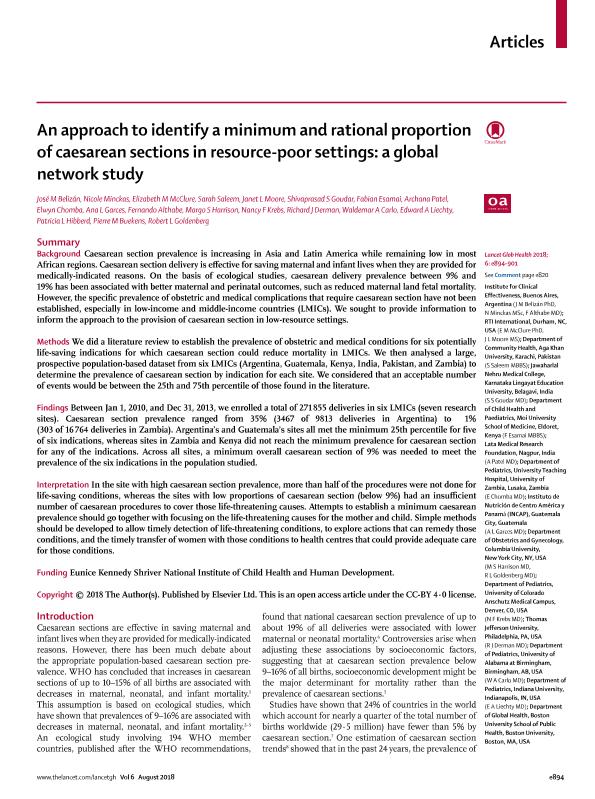Mostrar el registro sencillo del ítem
dc.contributor.author
Belizan, Jose

dc.contributor.author
Minckas, Nicole

dc.contributor.author
McClure, Elizabeth M.
dc.contributor.author
Saleem, Sarah
dc.contributor.author
Moore, Janet L.
dc.contributor.author
Goudar, Shivaprasad S.
dc.contributor.author
Esamai, Fabian
dc.contributor.author
Patel, Archana
dc.contributor.author
Chomba, Elwyn
dc.contributor.author
Garces, Ana L.
dc.contributor.author
Althabe, Fernando

dc.contributor.author
Harrison, Margo S.
dc.contributor.author
Krebs, Nancy F.
dc.contributor.author
Derman, Richard J.
dc.contributor.author
Carlo, Waldemar A.
dc.contributor.author
Liechty, Edward A.
dc.contributor.author
Hibberd, Patricia L.
dc.contributor.author
Buekens, Pierre M.
dc.contributor.author
Goldenberg, Robert L.
dc.date.available
2021-11-26T14:10:27Z
dc.date.issued
2018-08
dc.identifier.citation
Belizan, Jose; Minckas, Nicole; McClure, Elizabeth M.; Saleem, Sarah; Moore, Janet L.; et al.; An approach to identify a minimum and rational proportion of caesarean sections in resource-poor settings: a global network study; Elsevier; The Lancet Global Health; 6; 8; 8-2018; e894-e901
dc.identifier.issn
2214-109X
dc.identifier.uri
http://hdl.handle.net/11336/147491
dc.description.abstract
Background: Caesarean section prevalence is increasing in Asia and Latin America while remaining low in most African regions. Caesarean section delivery is effective for saving maternal and infant lives when they are provided for medically-indicated reasons. On the basis of ecological studies, caesarean delivery prevalence between 9% and 19% has been associated with better maternal and perinatal outcomes, such as reduced maternal land fetal mortality. However, the specific prevalence of obstetric and medical complications that require caesarean section have not been established, especially in low-income and middle-income countries (LMICs). We sought to provide information to inform the approach to the provision of caesarean section in low-resource settings. Methods: We did a literature review to establish the prevalence of obstetric and medical conditions for six potentially life-saving indications for which caesarean section could reduce mortality in LMICs. We then analysed a large, prospective population-based dataset from six LMICs (Argentina, Guatemala, Kenya, India, Pakistan, and Zambia) to determine the prevalence of caesarean section by indication for each site. We considered that an acceptable number of events would be between the 25th and 75th percentile of those found in the literature. Findings: Between Jan 1, 2010, and Dec 31, 2013, we enrolled a total of 271 855 deliveries in six LMICs (seven research sites). Caesarean section prevalence ranged from 35% (3467 of 9813 deliveries in Argentina) to 1% (303 of 16 764 deliveries in Zambia). Argentina's and Guatemala's sites all met the minimum 25th percentile for five of six indications, whereas sites in Zambia and Kenya did not reach the minimum prevalence for caesarean section for any of the indications. Across all sites, a minimum overall caesarean section of 9% was needed to meet the prevalence of the six indications in the population studied. Interpretation: In the site with high caesarean section prevalence, more than half of the procedures were not done for life-saving conditions, whereas the sites with low proportions of caesarean section (below 9%) had an insufficient number of caesarean procedures to cover those life-threatening causes. Attempts to establish a minimum caesarean prevalence should go together with focusing on the life-threatening causes for the mother and child. Simple methods should be developed to allow timely detection of life-threatening conditions, to explore actions that can remedy those conditions, and the timely transfer of women with those conditions to health centres that could provide adequate care for those conditions. Funding: Eunice Kennedy Shriver National Institute of Child Health and Human Development.
dc.format
application/pdf
dc.language.iso
eng
dc.publisher
Elsevier

dc.rights
info:eu-repo/semantics/openAccess
dc.rights.uri
https://creativecommons.org/licenses/by-nc-sa/2.5/ar/
dc.subject
caesarean
dc.subject
resource-poor settings
dc.subject
global network study
dc.subject.classification
Otras Ciencias de la Salud

dc.subject.classification
Ciencias de la Salud

dc.subject.classification
CIENCIAS MÉDICAS Y DE LA SALUD

dc.title
An approach to identify a minimum and rational proportion of caesarean sections in resource-poor settings: a global network study
dc.type
info:eu-repo/semantics/article
dc.type
info:ar-repo/semantics/artículo
dc.type
info:eu-repo/semantics/publishedVersion
dc.date.updated
2020-03-11T13:00:39Z
dc.journal.volume
6
dc.journal.number
8
dc.journal.pagination
e894-e901
dc.journal.pais
Países Bajos

dc.description.fil
Fil: Belizan, Jose. Consejo Nacional de Investigaciones Científicas y Técnicas. Oficina de Coordinación Administrativa Parque Centenario. Centro de Investigaciones en Epidemiología y Salud Pública. Instituto de Efectividad Clínica y Sanitaria. Centro de Investigaciones en Epidemiología y Salud Pública; Argentina
dc.description.fil
Fil: Minckas, Nicole. Instituto de Efectividad Clínica y Sanitaria; Argentina
dc.description.fil
Fil: McClure, Elizabeth M.. No especifíca;
dc.description.fil
Fil: Saleem, Sarah. The Aga Khan University; Pakistán
dc.description.fil
Fil: Moore, Janet L.. No especifíca;
dc.description.fil
Fil: Goudar, Shivaprasad S.. Jawaharlal Nehru Medical College Belgaum; India
dc.description.fil
Fil: Esamai, Fabian. Moi University; Kenia
dc.description.fil
Fil: Patel, Archana. Lata Medical Research Foundation; India
dc.description.fil
Fil: Chomba, Elwyn. University Teaching Hospital Lusaka; Zambia
dc.description.fil
Fil: Garces, Ana L.. No especifíca;
dc.description.fil
Fil: Althabe, Fernando. Consejo Nacional de Investigaciones Científicas y Técnicas. Oficina de Coordinación Administrativa Parque Centenario. Centro de Investigaciones en Epidemiología y Salud Pública. Instituto de Efectividad Clínica y Sanitaria. Centro de Investigaciones en Epidemiología y Salud Pública; Argentina
dc.description.fil
Fil: Harrison, Margo S.. Columbia University; Estados Unidos
dc.description.fil
Fil: Krebs, Nancy F.. University of Colorado; Estados Unidos
dc.description.fil
Fil: Derman, Richard J.. Thomas Jefferson University; Estados Unidos
dc.description.fil
Fil: Carlo, Waldemar A.. University of Alabama at Birmingahm; Estados Unidos
dc.description.fil
Fil: Liechty, Edward A.. No especifíca;
dc.description.fil
Fil: Hibberd, Patricia L.. Boston University; Estados Unidos
dc.description.fil
Fil: Buekens, Pierre M.. University of Tulane; Estados Unidos
dc.description.fil
Fil: Goldenberg, Robert L.. Columbia University; Estados Unidos
dc.journal.title
The Lancet Global Health
dc.relation.alternativeid
info:eu-repo/semantics/altIdentifier/doi/http://dx.doi.org/10.1016/S2214-109X(18)30241-9
dc.relation.alternativeid
info:eu-repo/semantics/altIdentifier/url/https://www.thelancet.com/journals/langlo/article/PIIS2214-109X(18)30241-9/fulltext
Archivos asociados
